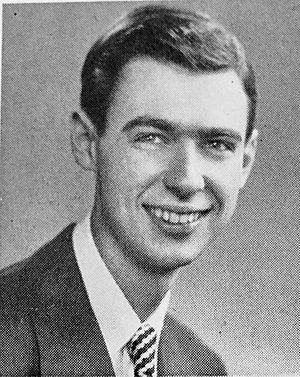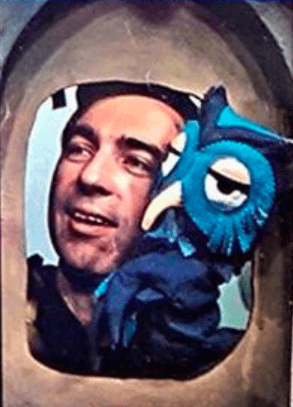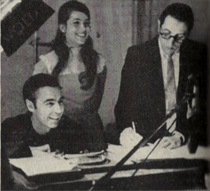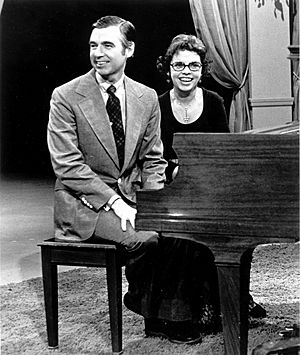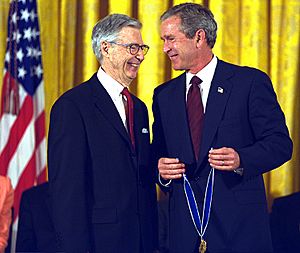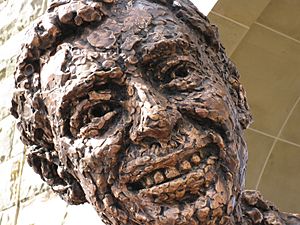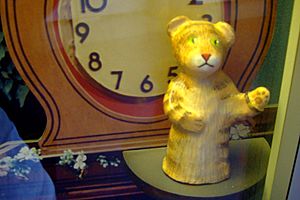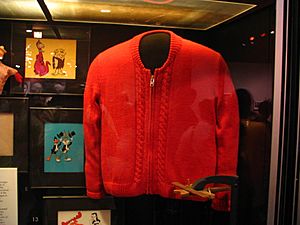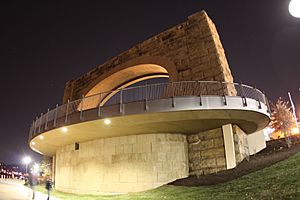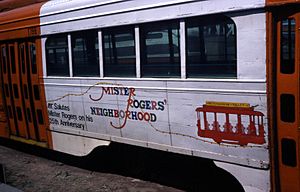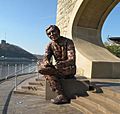Fred Rogers facts for kids
Quick facts for kids
Fred Rogers
|
|
|---|---|
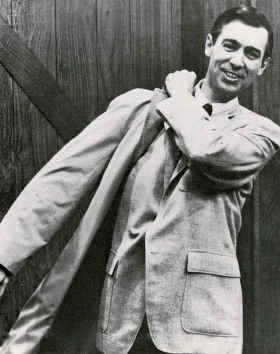
Rogers on the set of Mister Rogers' Neighborhood in the late 1960s
|
|
| Born |
Fred McFeely Rogers
March 20, 1928 |
| Died | February 27, 2003 (aged 74) Pittsburgh, Pennsylvania, U.S.
|
| Other names | Mister Rogers |
| Alma mater | Dartmouth College (attended) Rollins College (BA, 1951) Pittsburgh Theological Seminary (MDiv) |
| Occupation | Children's television presenter, actor, puppeteer, singer, composer, television producer, author, educator, Presbyterian minister |
| Years active | 1922–2003 |
| Spouse(s) |
Joanne Byrd
(m. 1952) |
| Children | 2 |
| Signature | |
Fred McFeely Rogers (March 20, 1928 – February 27, 2003) was an American television personality, musician, puppeteer, writer, producer, and Presbyterian minister. He was known as the creator, composer, producer, head writer, and host of the preschool television series Mister Rogers' Neighborhood from 1968 until his retirement in 2001.
Rogers was not happy with the television shows that children were seeing. He began to write and perform local Pittsburgh-area shows for children. In 1968, Eastern Educational Television Network began nationwide distribution of Rogers's new show on WQED. For thirty years, Rogers became a television icon of children's entertainment and education.
Rogers supported many public causes. In the Betamax case, the U.S. Supreme Court used Rogers's testimony before a lower court in favor of fair-use television show recording. Rogers also testified before a U.S. Senate committee to support government funding of children's television.
In August 2001, Rogers retired from recording Mister Rogers' Neighborhood. In October 2002, he was diagnosed with stomach cancer and died from the disease a few months later in February 2003.
Rogers was honored with the Presidential Medal of Freedom by President George W. Bush, forty honorary degrees, and a Peabody Award. He was added into the Television Hall of Fame. He was listed number 35 of the TV Guide's Fifty Greatest TV Stars of All Time. The Smithsonian Institution has one of his sweaters as a "Treasure of American History".
Contents
Early life
Rogers was born in Latrobe, Pennsylvania to James Rogers and Nancy McFeely. His father was a businessman. His mother came from a rich Pittsburgh family and also was a hospital volunteer during and after World War II. His grandfather from his mother's side, Fred McFeely, was the president of McFeely Brick, one of Latrobe's largest businesses. Rogers grew up in a large brick mansion at 737 Weldon Street in Latrobe.
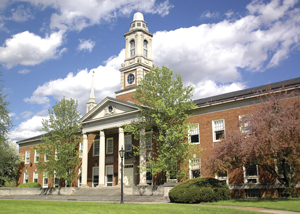
He had an adopted sister, Elaine. Rogers spent much of his free time with his grandfather McFeely, who loved music. Rogers began to play the piano when he was five and sang with his mother.
When growing up, Rogers was shy and overweight. He was home schooled many times because of his asthma. Rogers had a hard time making friends and would be bullied many times as a little boy for his weight, often called "Fat Freddy".
During his high school years in Latrobe, Rogers became more confident and popular. Rogers was president of the student council, a member of the National Honor Society and was editor-in-chief of the yearbook. He graduated in 1946. He studied at Dartmouth College from 1946 until 1948 and then went on at Rollins College in Winter Park, Florida to earn a BA in music composition in 1951.
While studying at Rollins, Rogers met Sara Joanne Byrd who was from Oakland, Florida. They were married on June 9, 1952. They had two sons: James, in 1959, and John, in 1961.
Rogers graduated from Pittsburgh Theological Seminary and was ordained a minister of the United Presbyterian Church in 1963. Rogers returned to Pittsburgh in the 1960s.
Television career
Early career
Rogers entered seminary after college but wanted to work with television. In an interview with CNN, Rogers said, "I went into television because I hated it so, and I thought there's some way of using this fabulous instrument to nurture those who would watch and listen". He applied for a job at NBC in New York City in 1951. He first worked as an assistant producer, and later as a network floor director on musical programs such as Your Hit Parade, The Kate Smith Hour, and The Voice of Firestone. He also worked on Gabby Hayes's children's show.
Rogers left NBC because he did not approve of the agency using children for advertisement. He began working as a puppeteer on the local children's show The Children's Corner for Pittsburgh public television station WQED in 1954. The show won a Sylvania Award for best children's show and was broadcast nationally on NBC.
Rogers studied theology at the nearby Pittsburgh Theological Seminary during his lunch breaks. However, he did not want to go into preaching and was told to continue making children's television after his ordination. He worked with the University of Pittsburgh's child development and care program.
In 1963, the Canadian Broadcasting Corporation (CBC) hired Rogers to create the 15-minute children's program Misterogers. Rogers moved to Toronto and the series ran for three seasons. Three years later, Rogers moved back to the United States.
In 1966, Rogers got the rights to his program from the CBC and moved the show to WQED in Pittsburgh, where he had worked on The Children's Corner.
Mister Rogers' Neighborhood
Mister Rogers' Neighborhood began in 1968 and ran for 895 episodes. It aired on National Educational Television, which later became The Public Broadcasting Service. The last set of new episodes was taped in December 2000 and began airing in August 2001. By 1985, eight percent of people living in the United States watched the show.
The program always started with Rogers coming home, singing his theme song "Won't You Be My Neighbor?". He would then change into sneakers and a zippered cardigan sweater. The sweaters were all knitted by his mother. In his show, Rogers would always go on trips, teach new things and show short movies on "Picture, Picture". Each episode included a trip to Rogers's "Neighborhood of Make-Believe" with a trolley, a castle, and the kingdom's citizens, including King Friday XIII.
Rogers always fed his aquarium fish during episodes. He would always say this to his audience he was feeding them because he received a letter from a young blind girl who wanted to know each time he did this. The program would end with Rogers winging "It's Such a Good Feeling".
Rogers believed not to act differently when he was being filmed to how he acted normally. He said that "One of the greatest gifts you can give anybody is the gift of your honest self. I also believe that kids can spot a phony a mile away". Rogers wrote almost all of the music on the program. He wanted to teach children to love themselves and others, and he talked about common childhood fears with comforting songs. He once took a trip to a children's hospital to show children that a hospital is not a place to fear.
Rogers would talk about social issues on his program including the assassination of Robert F. Kennedy, racism and divorce. One famous episode, Rogers soaked his feet with Officer Clemmons (François Clemmons), who was African-American, in a kiddie pool on a hot day. The scene was a message of inclusion during a time when racial segregation in the United States was common.
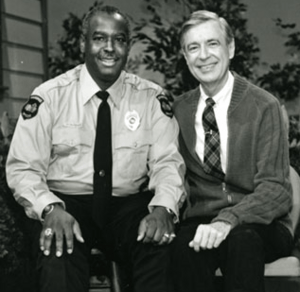
Rogers was also known for having children with disabilities on his show. In a 1981 episode, Rogers met a young quadriplegic boy, Jeff Erlanger, who showed how his electric wheelchair worked and explained why he needed it. Erlanger and Rogers both sang a duet of the song "It's You I Like". Before the taping, Erlanger had long been a fan of the program, and his parents wrote a letter to Rogers asking if they could meet.
Rogers would end each program by telling his viewers,
-
-
"You've made this day a special day, by just your being you. There's no person in the whole world like you; and I like you just the way you are"
-
Rogers never talked about his religious beliefs on the show because he did not want any viewer to feel ignored from the show. During the Gulf War, he comforted his audience that all children in the neighborhood would be well cared for. Rogers asked parents to promise to take care of their children.
After the September 11 terrorist attacks, Rogers taped public service announcements for parents about how to discuss tragic world news events with their children. He told viewers to "look for the helpers". The quote continues to go viral following tragic news events. Rogers said in the public service announcement,
-
-
"When I was a boy and I would see scary things in the news, my mother would say to me, 'Look for the helpers. You will always find people who are helping.' To this day, especially in times of "disaster," I remember my mother's words and I am always comforted by realizing that there are still so many helpers – so many caring people in this world"
-
PBS funding
In 1969, Rogers appeared before the United States Senate Subcommittee on Communications. His goal was to ask the Senate to support funding for PBS and the Corporation for Public Broadcasting, because proposed budget cuts. In about six minutes of testimony, Rogers spoke of the need for social and emotional education that public television gave. He argued that other television programming like his Neighborhood helped encourage children to become happy citizens.
The chairman of the subcommittee, John O. Pastore, did not know Rogers or his work and was sometimes said to be impatient. However, after Rogers, Pastore said that the testimony had given him goosebumps, and said, "I think it's wonderful. Looks like you just earned the $20 million". The Senate would soon increase PBS funding from $9 million to $22 million.
Role in Sony Corp. of America v. Universal City Studios, Inc.
During the issues of households being able to record television programs with a VCR grew, Rogers was active in supporting VCR companies in court. His 1979 testimony, in the case Sony Corp. of America v. Universal City Studios, Inc., Rogers said he was not against home recordings of his television programs because families could watch them together at a later time.
When the case reached the Supreme Court in 1983, the majority decision thought about the testimony Rogers gave. The court found that the Betamax video recorder did not commit copyright violations. The court said that his views were an important piece of evidence "that many [television] producers are willing to allow private time-shifting to continue".
In 1978, while taking a break from taping new Neighborhood episodes, Rogers hosted an interview program for adults on PBS called Old Friends...New Friends. On the show, Rogers interviewed "actors, sports stars, politicians, and poets". The show was lasted only 20 episodes. In 1988, he appeared on the Soviet children's television show Good Night, Little Ones! where he brought his puppet Daniel Striped Tiger with him.
The only time Rogers appeared on television as someone other than himself was in 1996 when he played a preacher on one episode of Dr. Quinn, Medicine Woman. Rogers voiced himself on the "Arthur Meets Mister Rogers" episode of the PBS Kids series Arthur.
Personal life
Rogers met Sara Joanne Byrd (called "Joanne") from Jacksonville, Florida, while attending Rollins College. They were married from 1952 until his death in 2003. They had two sons, James and John. Joanne was "an accomplished pianist". Joanne died on January 14, 2021 at the age of 92.
Rogers had an apartment in New York City and a summer home on Nantucket Island in Massachusetts. Rogers was red–green color blind. He had a healthy lifestyle as he swam every morning and neither smoked nor drank. He was a vegetarian because he believed eating meat was wrong, saying "I don't want to eat anything that has a mother". Despite popular rumors, he never served in the military as a Navy SEAL during the Vietnam War and never had tattoos.
In 1991, the Pittsburgh Penguins named Rogers as their celebrity captain, as part of a celebration of the National Hockey League's 75th anniversary. Card No. 297 from the 1992 NHL Platinum collection celebrated the event, making Rogers one of only twelve celebrity captains to be chosen for a sports card.
During his morning routine, Rogers would respond to every single fan mail and return them to the respective sender.
In 1992, he was awarded the Peabody Award. He was added into the Television Hall of Fame in 1999.
Death

After Rogers' retirement in 2001, he remained busy working from studying religion and spirituality, making public appearances, traveling, and working on a children's media center named after him at Saint Vincent College in Latrobe with Archabbot Douglas Nowicki, chancellor of the college.
By the summer of 2002 his constant stomach pain had become painful enough for him to see a doctor about it, and in October 2002 he was diagnosed with stomach cancer. He had surgery on January 6, 2003, which was unsuccessful. A week earlier, he was grand marshal of the Tournament of Roses Parade, with Art Linkletter and Bill Cosby.
Rogers died on the morning of February 27, less than a month before his 75th birthday.
More than 2,700 people went to his memorial service at Heinz Hall. Honorary guests included former Good Morning America host David Hartman, Teresa Heinz Kerry, philanthropist Elsie Hillman, PBS President Pat Mitchell, Arthur creator Marc Brown, and The Very Hungry Caterpillar author-illustrator Eric Carle. Speakers remembered Rogers for his love of children, devotion to his religion, love for music, and humor. Teresa Heinz Kerry said of Rogers, "He never condescended, just invited us into his conversation. He spoke to us as the people we were, not as the people others wished we were". Rogers is buried at Unity Cemetery in Latrobe.
Legacy
President George W. Bush awarded Rogers the Presidential Medal of Freedom in 2002 for his works to children's education. He said that "Fred Rogers has proven that television can soothe the soul and nurture the spirit and teach the very young".
In 2003, the United States Senate passed Resolution 16 to celebrate the life of Rogers. Following Rogers' death, the U.S. House of Representatives in 2003 passed Resolution 111 honoring Rogers for "his legendary service to the improvement of the lives of children, his steadfast commitment to demonstrating the power of compassion, and his dedication to spreading kindness through example".
On New Year's Day 2004, Michael Keaton, who worked on stage on Mister Rogers' Neighborhood before becoming an actor, hosted the PBS TV special Fred Rogers: America's Favorite Neighbor. His hometown of Latrobe and Pittsburgh host "Won't You Wear a Sweater Day" to honor Rogers. The event takes place annually on his birth date, March 20. In 2003, the asteroid 26858 Misterrogers was named after Rogers by the International Astronomical Union.
One of Rogers' famous sweaters was bought by the Smithsonian Institution, which has it shown on their "Treasure of American History" exhibit. The Fred Rogers Memorial Statue in Pittsburgh was dedicated in 2009.
On June 25, 2016, the Fred Rogers Historical Marker was placed near Latrobe, Pennsylvania in his memory.
In June 2018, the documentary Won't You Be My Neighbor? based on the life and legacy of Rogers, was released to positive reviews and became the highest money making biography-documentary (biodioc) of all time. Tom Hanks played Rogers in a movie based on his later life titled A Beautiful Day in the Neighborhood (2019) directed by Marielle Heller. Hanks would soon be nominated for an Academy Award for Best Supporting Actor for his role as Rogers.
Rogers was honored on a special United States postage stamp in March 2018. On September 21, 2018, Google Doodle honored him with a stop-motion video of Mister Rogers' Neighborhood. On October 23, 2018, during the first game of the 2018 World Series, Rogers's first television commercial aired for Google's Pixel 3 smartphone. In the ad, Rogers sings "Did You Know" which is the first time his voice or images has been used in a commercial for a product on television.
In December 2019, it was announced that a statue of Rogers would be placed in at Nantucket Park in Nantucket, Massachusetts.
At the 2020 Academy Awards, Janelle Monáe performed Rogers' "Its a Beautiful Day in This Neighborhood" during the opening ceremony while wearing a red cardigan sweater. During her acceptance speech for the Academy Award for Best Actress, Renée Zellweger listed Rogers as one of the heroes people should look for.
Programs
| Year | Title |
|---|---|
| 1954–1961 | The Children's Corner |
| 1963–1966 | Misterogers |
| 1964–1967 | Butternut Square |
| 1968–2001 | Mister Rogers' Neighborhood |
| 1977–1982 | Christmastime with Mister Rogers |
| 1978–1981 | Old Friends ... New Friends |
| 1981 | Sesame Street |
| 1988 | Good Night, Little Ones! |
| 1991 | Where in the World Is Carmen Sandiego? |
| 1994 | Fred Rogers' Heroes |
| 1996 | Dr. Quinn, Medicine Woman |
| 1997 | Arthur |
| 1998 | Wheel of Fortune |
| 2003 | 114th Annual Tournament of Roses Parade |
Children's books
- Our Small World (with Josie Carey, illustrated by Norb Nathanson), 1954, Reed and Witting,
- The Elves, the Shoemaker, & the Shoemaker's Wife (illustrated by Richard Hefter), 1973, Small World Enterprises,
- The Matter of the Mittens, 1973, Small World Enterprises,
- Speedy Delivery (illustrated by Richard Hefter), 1973, Hubbard,
- Henrietta Meets Someone New (illustrated by Jason Art Studios), 1974, Golden Press,
- Mister Rogers Talks About, 1974, Platt & Munk,
- Time to Be Friends, 1974, Hallmark Cards,
- Everyone is Special (illustrated by Jason Art Studios), 1975, Western Publishing,
- Tell Me, Mister Rogers, 1975, Platt & Munk,
- The Costume Party (illustrated by Jason Art Studios), 1976, Golden Press,
- Planet Purple (illustrated by Dennis Hockerman), 1986, Texas Instruments, ISBN: 978-0-89512-092-2
- If We Were All the Same (illustrated by Pat Sustendal), 1987, Random House,
- A Trolley Visit to Make-Believe (illustrated by Pat Sustendal), 1987, Random House,
- Wishes Don't Make Things Come True (illustrated Pat Sustendal), 1987, Random House,
- No One Can Ever Take Your Place (illustrated by Pat Sustendal), 1988, Random House,
- When Monsters Seem Real (illustrated by Pat Sustendal), 1988, Random House,
- You Can Never Go Down the Drain (illustrated by Pat Sustendal), 1988, Random House, ISBN: 978-0-394-80430-9
- The Giving Box (illustrated by Jennifer Herbert), 2000, Running Press,
- Good Weather or Not (with Hedda Bluestone Sharapan, illustrated by James Mellet), 2005, Family Communications,
- Josephine the Short Neck-Giraffe, 2006, Family Communications,
- A Beautiful Day in the Neighborhood: The Poetry of Mister Rogers Neighborhood (illustrated by Luke Flowers), 2009, Quirk Books,
Images for kids
-
Rogers and François Clemmons having a foot bath in 1969, breaking a well-known color barrier.
-
Memorial statue in Pittsburgh, Pennsylvania, created by Robert Berks; opened to the public on November 5, 2009
-
Rogers being presented the Presidential Medal of Freedom by President George W. Bush in the East Room of the White House on July 9, 2002
See also
 In Spanish: Fred Rogers para niños
In Spanish: Fred Rogers para niños


